Can Quantum Physics Explain Consciousness? One Scientist Thinks It Might
Fellow scientists labeled him a crackpot. Now Stuart Hameroff's quantum consciousness theories are getting support from unlikely places.
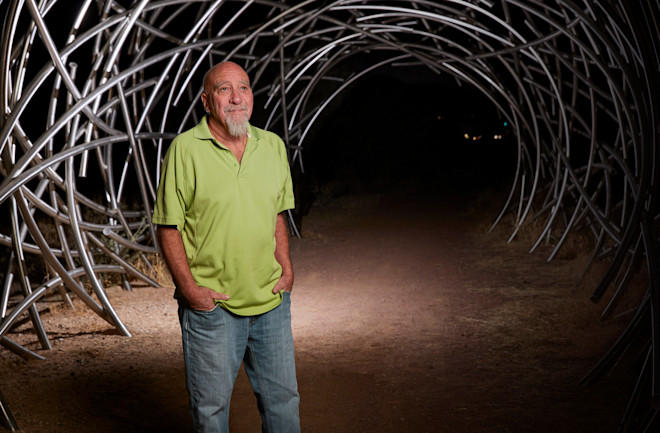
Newsletter
Stuart Hameroff is an impish figure — short, round, with gray hair and a broad, gnomic face. His voice is smoke — deep and granular, rumbling with the weight of his 70 years. For more than two decades, he's run a scientific conference on consciousness research. He turns up each day in rumpled jeans and short-sleeved shirts. The effect is casual bordering on slovenly. But up close, he is in charge, and to his critics, he comes off as pugnacious.
He may not care so much about how he's dressed. He cares a great deal about how he and his theories are addressed.
Hameroff is best known for serving as a kind of gadfly in the fields of neuroscience and philosophy. He emerged in 1994 from the windowless bowels of the Arizona hospital where he still works as an anesthesiologist to put forward what seemed — at the time — some of the more outlandish ideas about the human brain.
Most neuroscientists say thoughts are born from brain cells called neurons. Hameroff suggests the most meaningful action happens at the impossibly small quantum level, where subatomic particles like photons and electrons exhibit bizarre behavior. Quantum physics drives consciousness, he believes.
If Hameroff proposed these ideas himself, he might have been ignored, but his co-theorist was Sir Roger Penrose, an esteemed figure in mathematical physics. Their theory, dubbed "orchestrated objective reduction," or Orch-OR, suggests that structures called microtubules, which transport material inside cells, underlie our conscious thinking.
But the Penrose-Hameroff model of what you'd call quantum consciousness was a scientific non-starter. Leading experts dismissed the new model outright. Quantum effects, the criticism went, are notoriously difficult to maintain in the lab, requiring ultracold temperatures and shielding to protect against even the mildest interference. Critics said living things are simply too "warm, wet and noisy" to allow significant quantum effects to persist. What's more, neuroscientists argued, the Penrose-Hameroff model offered no testable hypotheses.
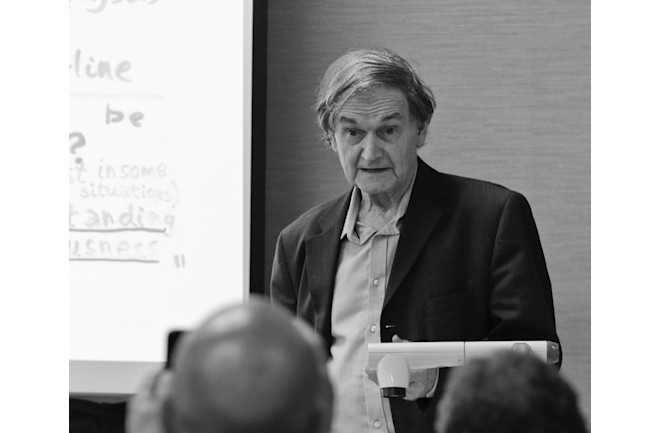
The pair disagreed unequivocally, churning out more papers over the years. But while Penrose's reputation is too towering to destroy, Hameroff seemed to find his firmest footing through pop culture. He embraced support from Deepak Chopra, an author and New Age guru of quantum consciousness theories. He was also featured in What the Bleep Do We Know?, a film that angered scientists for pushing a quantum mysticism that underlies our nuts-and-bolts existence.
Along the way in 2006, Hameroff gave a talk that encapsulated his relationship with the scientific community. At a conference called "Beyond Belief" that was packed with leading luminaries from many disciplines, he presented his theories on everything from consciousness to a quantum mechanics-based "spirituality." At the end, prominent physicist Lawrence Krauss spoke from his seat in the audience. "From a physics perspective," he said, "everything you said is nonsense."
Many regard Hameroff as nonsensical, a creature from a Lewis Carroll story calling out from under a toadstool that we've got it all wrong, that some kind of quantum magic undergirds our brain function.
But just four years later, a shift was underway. In 2010, Hameroff was invited to speak at a less public meeting, at Google's campus in Mountain View, California. His presentation suggested he might have a firmer view of reality than some may have thought.
Hameroff and several other scientists were invited by Hartmut Neven, a Google researcher in visual search technologies. By then, scientists were already trying to tap the laws of quantum physics to build smaller, smarter computers. And biologists had begun to suspect quantum physics could be important to processes like photosynthesis and migration using Earth's magnetic field. Neven says he was interested in Hameroff's research because understanding the brain's efficiencies could bring huge cost savings for Google.
"I think it is rather remarkable that the human brain is able to accomplish its tremendous feats on just a spoonful of sugar a day," Neven says.
A funny thing happened on Hameroff's trip through the weedy fields of scientific derision: Data appeared.
The data isn't enough to confirm Orch-OR, but the new findings suggest some of Hameroff's claims are more plausible than previously supposed. Furthermore, the microtubule — the tiny structures that Hameroff thinks house quantum operations in the brain — is suddenly a hot subject. And two researchers are finding that the old anesthesiologist might be right: Quantum physics might be vital to our awareness, cognition and even memory.
Read more: The Biocentric Universe Theory: Life Creates Time, Space, and the Cosmos Itself
The Hard Problem
Despite Hameroff's controversial standing in the scientific community, the conferences he hosts remain a good get for neuroscience researchers and philosophers. At his first consciousness conference in Tucson, Arizona, in 1994, a young philosopher named David Chalmers — a leather-jacketed Australian, then topped by the long, shaggy hair of a heavy metal fan — made waves with a new interpretation of an ancient question.
Chalmers argued that some problems associated with cognitive studies are relatively "easy" to solve. Most information processing, such as driving a car, is mere computation. And for this, firing neurons suffice. The "hard problem," he says, is the existence of consciousness itself. The same wiring in our brain lets us enjoy eating an apple and also lets us imagine eating one when no actual apple is around. Science can't explain precisely how. Theories already abounded, and researchers like neuroscientist Christof Koch — partnered with Francis Crick, the co-discoverer of the DNA molecule — sought what he called the neural correlates of consciousness.
But where most stuck to orthodox understandings of physics and neuroscience, Hameroff came in touting his more out-there ideas.
During the 2016 Tucson Science of Consciousness Conference, Hameroff was treated with the respect accorded a conference organizer and also made the butt of occasional jokes. Audible groans could be heard in the audience, for instance, when Hameroff took the microphone and related whatever was just presented back to his own theory.
But over lunch, on a particularly hot day at the conference's midpoint, Hameroff sought a seat in the shade and argued that he merely gives as good as he gets: His critics may couch their judgments in academic niceties, he says, but essentially they're saying he wasted his career in a wrong-headed attempt to steer neuroscience into sheer speculation and quantum woo.
"Roger is still on board," he says of Penrose. "To be honest, we kind of feel like we're riding high."
Penrose remains committed to what the pair has co-published over the years — the theoretical science. They differ off the page. Penrose has been mostly mum on the philosophical implications of their theory. Hameroff has freely speculated on what it all means. For instance, he posited that near-death experiences might reflect something real: a potentially short-lived quantum afterlife.
The challenge, then, is to set aside Hameroff's speculations and look instead at what he and Penrose have published, and how this odd couple came to be partners in the first place.
Hameroff's biography, and at least some of his claims, are more firmly rooted in science than his critics normally allow.
Carnival Barker's Son
Hameroff was born in 1947 in Buffalo, New York. His father, Harry, performed as a carnival barker and as a comedian in burlesque theater and vaudeville. His grandfather Abraham was a huge influence on him. He'd buy the young Stuart books on science and teach him about Einstein. "He was kind of an intellectual dilettante," says Hameroff. "He knew a lot about a lot."
When it was time to pursue a higher education, Hameroff was already deeply interested in the "mind-body problem"— in essence, Chalmers' "hard problem" before he coined the term.
Hameroff chose medical school, but finding a specialty eluded him. Neurology? Psychiatry? During an internship at the Tucson Medical Center, the chairman of the anesthesiology department told him that anesthesiology was key to understanding consciousness. So Hameroff investigated, and his career in anesthesiology quickly took shape.
Hameroff says that a patient under anesthesia exhibits relatively normal brain function save one thing: consciousness. Neurons keep firing, and even pain signals travel their normal routes. But that pain is never felt, never experienced. The science of anesthesia sits right at the heart of the hard problem — allowing "easy" computational processes to continue while selectively eliminating subjective experience. But no one knows quite how.
Early on in his career, Hameroff suspected microtubules might provide an answer. Microtubules were discovered by accident in the 1960s. Over the coming decades, they proved to be among the most versatile biological structures in nature. Tubulin, a flexible protein, assembles into a long chain to create microtubules. These 25-nanometer-wide tubes — thousands of times smaller than a red blood cell — are found in every cell in plants and animals.

Microtubules act as the crucial cytoskeleton, supporting the structure of living cells; as conveyor belts, moving chemical components from one cell to another; and as movers themselves, taking on different formations and dividing chromosomes. During cell division, microtubules move chromosomes from one end of the cell to the other, then position the chromosomes in the new daughter cells. Microtubules even come into play on the outside of cells, forming into cilia and flagella that allow for cell movement. That makes these structures something like the Transformers of biology.
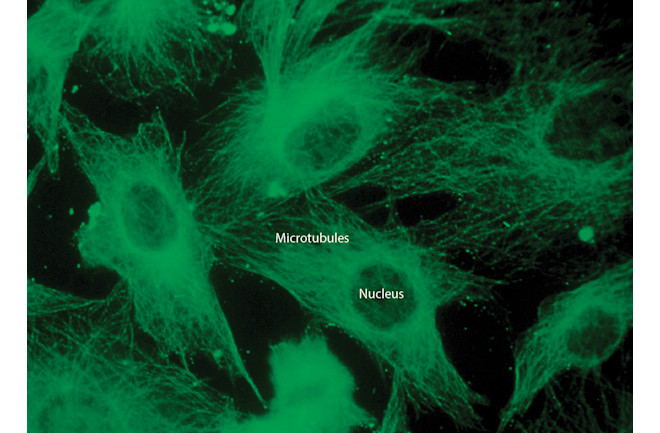
Hameroff came to believe the microtubule plays a defining role in anesthesia effects — in consciousness. He points to the single-celled paramecium as evidence. "The paramecium has no central nervous system," he says. "No brain, no neurons, but it swims around, finds food, finds a mate and avoids danger. It seems to make choices, and it definitely seems to process information."
How? Or more to Hameroff's point, where? In what part of the paramecium does this crude kind of cognition take place? Hameroff believed he could find the answers in the paramecium's only internal structure: microtubules, the paramecium's cytoskeleton. And since these are nanoscale structures, he also began thinking that quantum physics might play a role. But throughout the 1980s, his research got nowhere in terms of public recognition. Then, one night in 1990, he sat down to read Penrose's book The Emperor's New Mind, a surprising best-seller that winds through physics, cosmology, mathematics and philosophy before marking a final, slam-bang stop at consciousness.
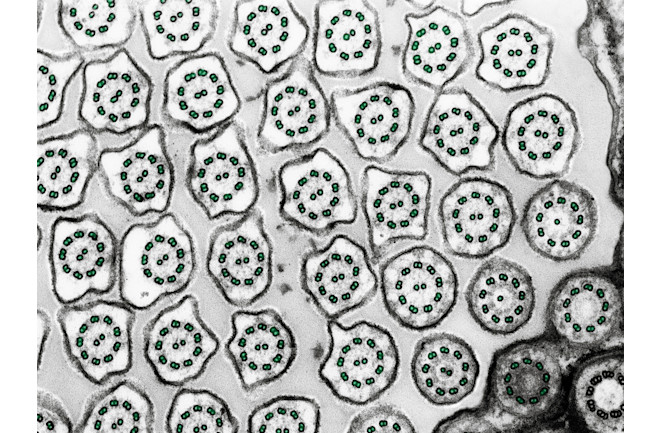
In his concluding pages, Penrose wonders how firing neurons generate experience. He opines that quantum physics might be necessary to understand consciousness.
But where in the body — an inhospitable place for delicate quantum perturbations — could such happenings take place? Hameroff felt an immediate connection to Penrose. And of course, he thought microtubules held the answer.
From afar, the two seemed like an odd pairing: Penrose is one of the more respected scientists of the last half-century, and his work in cosmology and general relativity has garnered him high honors. Hameroff was a relative unknown, shouting about an obscure biological structure. But within a few years, they were co-authoring papers together, and drawing the scorn of a generation of fellow scientists.
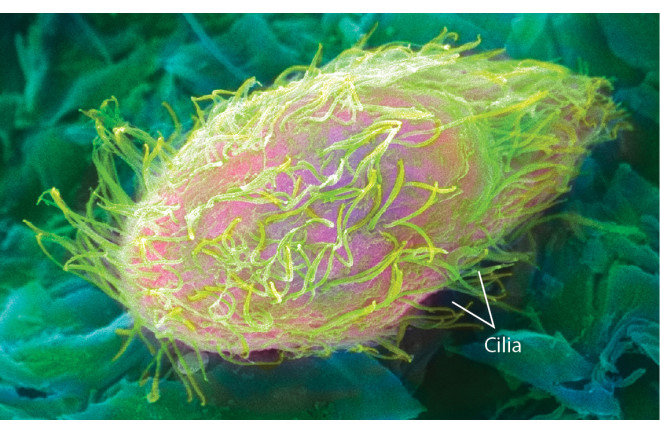
Data Arrives
In sum, Orch-OR proposes that consciousness originates from microtubules and actions inside neurons, rather than the connections between neurons. Whack a tennis ball with a racket, and afterward you can use traditional physics to predict where it is at any particular point. But in the quantum realm, such expectations go out the window. Movements are unknown until they're observed, according to the traditional interpretation of quantum mechanics. Physicists refer to this final observation, which determines what happened, as a wave "collapsing" into a single state.
In quantum systems inside the neuron, Hameroff and Penrose argue that it's each collapse of the wave function that yields a conscious moment.
Hameroff and Penrose were guilty of invoking one mystery to solve another: We don't understand consciousness, and we don't understand quantum physics, so maybe they explain each other?
So Orch-OR was and remains vulnerable to attack — and many do so with tremendous gusto. Two decades ago, neurophilosopher Patricia Churchland and physicist Max Tegmark were among those who launched outright broadsides. Hameroff and Penrose responded, and Hameroff published a list of 20 testable predictions yielded by Orch-OR.
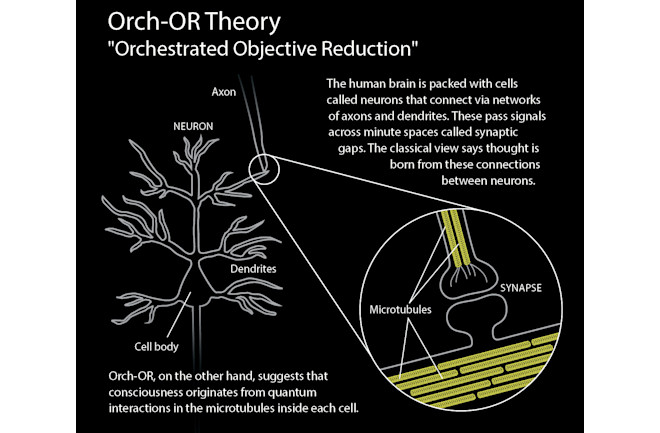
However, the greater theory serves as something of a distraction from some of Hameroff's ideas: that quantum physics might play a non-trivial role in human cognition and consciousness, and that microtubules — activity inside the neuron — could house these quantum happenings.
"If you would have speculated in this direction, say, 10 years ago, you would have been labeled a crackpot," says Google's Neven.
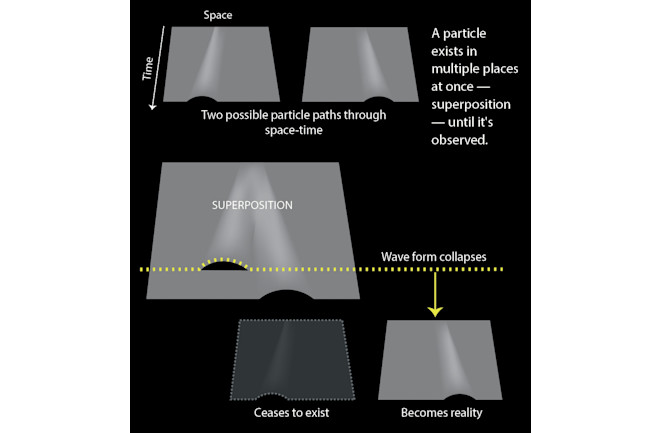
But researchers recently have found quantum effects are important for certain biological processes, like photosynthesis. When a photon strikes an electron in a leaf, the electron delivers it to another molecule dubbed the reaction center, which converts that light into chemical energy to feed the plant. Scientists always thought the process looked almost too efficient because very little excess energy is lost in the process.
Then in 2007, researchers started to suspect quantum physics was behind this efficiency. The electron could use the quantum effect of superposition, where a particle can be in two places at once, to test several routes to the reaction center where photosynthesis takes place, and take the most efficient one. The concept isn't yet proven, but it has gained traction. Neven says scientists are now careful not to dismiss such ideas outright.
For example, in a recent Nature Physics paper, physicist Neill Lambert of the Advanced Science Institute in Japan called out new photosynthesis research as remarkable just for suggesting quantum effects can happen in biological systems at room temperature.
And most recently, Rod Eckenhoff, a University of Pennsylvania researcher and Hameroff critic, gave tadpoles anesthetics to tease out what molecules they bind to. His team discovered that tubulin proteins were among them, and then found that if a kind of reverse agent were administered — a microtubule-stabilizing drug — so were the anesthetic effects. He remains a critic of Hameroff's "speculative" theories, but says his research suggests microtubules might play "some role" in consciousness.
Yet Hameroff remains controversial. Koch, the brain researcher and consciousness expert, declined to comment, saying he doesn't want to be the "eternal critic" everyone goes to for takedowns of the Hameroff-Penrose theory. But some are coming around.
"I was always quite skeptical of Stuart's claims about microtubules," says Anthony Hudetz, a neuroscientist in the anesthesiology department at the University of Michigan. "But now there is data. And I have to say, I think Stuart does have some momentum now."
Hudetz sees microtubules as a good potential mechanism for explaining anesthesia. "I have the feeling that this whole microtubule theory has matured actually quite nicely," he says. For Hudetz, the key going forward is testing whether molecular events inside microtubules actually relate to the quantum events as Hameroff proposes.
And now, two scientists working independently of one another, yet both openly inspired by Hameroff, are taking microtubule research to a whole new level.
Inside The Neuron
Anirban Bandyopadhyay summarized his research in a talk at Hameroff's 2016 Science of Consciousness conference. Six feet tall and slim with dark, black hair and a broad, joyful smile, Bandyopadhyay enjoys a plum job for a scientist in his early 40s, leading his own research group at the National Institute for Materials Science (NIMS) in Japan. As a physicist, he's studied the inner workings of both natural and artificial brains. To understand brain function, Bandyopadhyay believes scientists must understand the workings inside the neuron, including the microtubule.
The conventional view is that neurons fire when a channel within the cell membrane opens, flooding the neuron with positively charged ions. Once a specific threshold is reached, an electrical signal travels down the axon — the nerve fibers within the neuron — and the neuron fires. Axons are long wires that connect neurons to other cells. And inside each axon is a bundle of nanowires, including the microtubule.
Bandyopadhyay found that he could apply one of these specific charges to the microtubule, causing activity to build up in the neuron. By allowing the current to continue, he could cause the neuron to fire, or — by cutting the signal off — stop it from firing altogether.
He says this bundle of nanowire resonates like a guitar string, firing thousands of times faster than normal activity in a neuron. The neuron, he thought, contrary to all current scientific understanding, wasn't the essential, or first cause of the human thought process.
"[Neuroscientists] need to go deeper — into the microtubule," he says.
To Bandyopadhyay, modern brain science's emphasis on the neuron is misguided. Brash at times, he refers to neuroscience as akin to dermatology.
"The neuron is the skin," he says. "It's important, yes, but not everything."
Fringe or Frontier?
Bandyopadhyay's 2013 work on the microtubule required refitting a special microscope and contracting with an outside firm to create a needle with a 1-by-1-nanometer point — the smallest ever constructed, Bandyopadhyay says. His team used it to peer inside the microtubule with incredible precision.
Bandyopadhyay inserted the needle into a rat neuron to view the microtubule. As he did, monitors on one wall in the room flickered with images from the tiniest level of animal biology. The next set of experiments was to apply various electrical charges and watch the "skin" of the neuron as well as the inside of the microtubule. At first, nothing happened. But when he began applying specific energy charges to the microtubule, it responded, vibrating and conducting the electricity. This was curious, and exciting.

A microtubule is composed of many individual subunits. If they operated in a purely classical fashion, as insulators — like wood, glass and other common materials that stop electrical current from flowing freely — the amount of resistance across the microtubule should increase. But Bandyopadhyay found something very different when he applied specific charges of alternating current. Resistance levels jumped by a factor of 1 billion. The microtubule was acting something like a semiconductor, one of the most important developments in electronics. He stood there in wonder at his own results.
"When you get results like this," he says, "you are scared. Am I wrong somehow?"
But he checked, even having colleagues outside his lab at NIMS look over his results. In subsequent experiments, he saw that this conducting activity in the microtubule preceded neuronal, or membrane-level, firing. His microtubules research appeared in the journal Biosensors and Bioelectronics. And he has another study still under peer review.
The findings still need to be replicated by other scientists. But those touting Bandyopadhyay's findings are philosophical about his standing.
"If you're looking for frontier science, you have to drive out to the edge of what's known," says David Sonntag, a toxicologist who formerly worked in Tokyo for the U.S. Air Force's research and development wing and helped fund some of Bandyopadhyay's research.
"If you take a wrong turn," he says, "you'll run into its crazy next-door neighbor, fringe science. The issue is understanding when you're at the bifurcation point. When does the fringe become the frontier?"
For now, Bandyopadhyay remains clearly on the fringe. But he has brought something new to the debate: an experiment that can be replicated, or not, and a different perspective on Hameroff.
He is careful to distance himself from Hameroff's larger theory of consciousness. "This is not my concern," he says. Still, he describes Hameroff as a father to his own research. "This man was talking about microtubules back in 1982," he says. "Just thinking about them, unable to study them as I have, he knew, and so far ahead of everyone else. I wondered, 'What kind of brain has he got?' "
A Circuit's Missing Element
There is also another far more experienced scientist working the same vein of research and seeing dramatic results regarding the microtubule.
Jack Tuszynski, a biophysicist at the University of Alberta, is a longtime Hameroff collaborator who creates cancer drugs. His latest findings suggest microtubules have interesting conductive properties, but indicate they could also be what are called "memristors." The memristor is the much sought-after fourth element in an electrical circuit, first theorized by Leon Chua, an electrical engineer at the University of California, Berkeley.
Chua spotted something obvious. The three existing circuit elements — resistor, capacitor and inductor — depend on relationships between pairs that control how electricity flows, how it gets stored and how it changes as it moves through a circuit:
• resistor (voltage + current)
• capacitor (voltage + charge)
• inductor (magnetic flux + current)
By studying the pairs, Chua theorized there should be a fourth circuit element governing the relationship between the "missing" pair — charge and flux. Chua coined the term memristor, playing off the words memory and resistor, and from there his work was strictly mathematical. If such a circuit element existed, what would it do? Chua's equations suggested that a memristor's electrical resistance, or conductivity, would not be constant, like a lightbulb's, but dynamic, and determined by the history of the current that had flowed through the device.
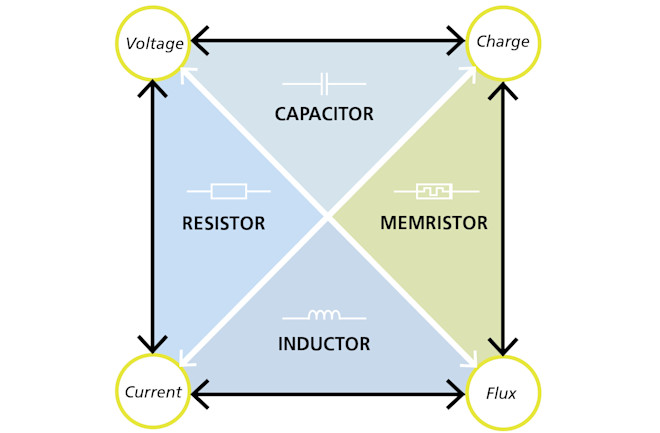
What's the big deal? In transistors, any interruption in the flow of electrons results in data loss. Memristors, however, incorporate both electron flow and ions — electrically charged atoms.
Because they remember the charge that previously passed through the material, information could be retained even when turned off. In computers, the innovation means no more rebooting. Computers would turn on like lightbulbs, and hard drives would become a thing of the past.
The race is on to build memristor chips at a cost scalable to consumer computers, and for good reason: Memristors require perhaps 1 percent of the energy of a standard chip. And while standard computer chips are limited to the binary code of 0s and 1s, memristors deal in fractional units of information — a development considered key in building computers that behave like the human brain.
Tuszynski wasn't familiar with memristors until he met Chua at a 2015 conference in India. "I think microtubules are memristors," Chua told him, revealing a longstanding interest in Hameroff's work. Chua was particularly struck, he says, when he once heard Hameroff point out that microtubules are ubiquitous in nature, while neurons are not. This insight — really, a simple statement of fact — struck Chua as crucial. "All of these biological systems engage in a kind of information processing," he says. "So how do they do it?"
He thought Hameroff had found the answer in microtubules.
Tuszynski is very different from Hameroff, his longtime research collaborator. Stolid and practical, he's published more than 400 papers in peer-reviewed publications, toiling in the earthy fields of precision medicine and computational biology. "Stuart, I think, is very prone to speculation," he says. "In many respects, he is his own worst enemy and would be better off if he limited himself a bit. But Stuart is a genius. His work on microtubules, prior even to ever getting involved with Penrose, is brilliant, and it is the reason I work on microtubules today."
To test the memristor theory, Tuszynski's team filled a dish with microtubules, tubulin proteins and a buffer solution, then added electricity. Over the course of many weeks, he found a fascinating result. The more he replaced the buffer solution with more microtubules, the better the conductance.
"The conductance increased by two- or threefold with the increased presence of microtubules," says Tuszynski, suggesting the microtubules were better at conducting energy than the buffer solution.
Further, he found the signature memristor effect: When he reversed the flow of electricity, as in an alternating current, the efficiency of the conductance increased, as if the microtubule had remembered the current that previously passed through it.
Tuszynski's lab published a paper last summer on the conductive properties of microtubules in Nature Scientific Reports, and it is preparing a paper on microtubules as memristors. If these results hold up, it could support Hameroff's case.
The Quantum Realm
The last morning of the conference in Tucson, Hameroff slowly rolls a suitcase out to the lobby and plops down in a lounge chair to handle a few more administrative duties.
"I think it went well," he says. "People are telling me they enjoyed it. I organized this, so that could be bullshit. But I think they mean it."
This being a Hameroff production, there was a fair amount of combat. Chalmers accused Hameroff of taking the conference too far into the quantum realm.
Hameroff has a ready response. He was able to include so many quantum-oriented conference sessions, he says, because quantum biology is a growing field.
Of course, none of this is to say that Hameroff wins this debate. He has yet to reframe fringe as frontier, and he may never. But in this moment, with scientific success being in part a simple function of math — is an idea gaining or losing adherents? — he is clearly on the way up, and that is perhaps never so apparent as when he gets up to leave.
With one hand on the handle to his luggage, he is immediately stopped. Hudetz, the anesthesiologist who was once dismissive of Hameroff, walks over to say hello. He tells his host, with seeming earnestness, "It was a very good conference, Stuart. I had a great time."
Hameroff thanks him. They banter a bit, and Hudetz turns to walk away. "You know," says Hameroff, stopping him, "you ought to do some research on microtubules."
"It's funny you should say that," Hudetz replies. "Because we're talking about it in my lab. There's some interest. We might just do that."
Steve Volk is a contributing editor at Discover.



No comments:
Post a Comment